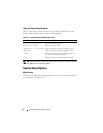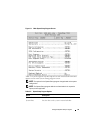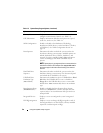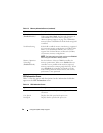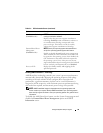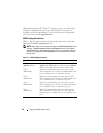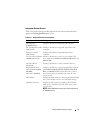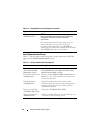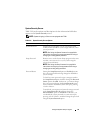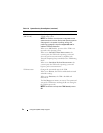
48 Using the System Setup Program
CPU Information Screen
Table 2-4 lists the options and descriptions for the information fields that
appear on the CPU Information screen.
Redundant Memory
(Disabled default)
Enables or disables the redundant memory feature.
When set to Spare Mode, the first rank of memory on
each DIMM is reserved for memory sparing (see
"Memory Sparing Support" on page 128). Redundant
memory feature is disabled if the Node Interleaving field
is enabled.
Node Interleaving If this field is enabled, memory interleaving is supported
if a symmetric memory configuration is installed. If this
field is set to disabled (the default), the system can
support Non-Uniform Memory architecture (NUMA)
(asymmetric) memory configurations.
NOTE: The Node Interleaving field must be set to Disabled
when using the redundant memory feature.
Memory Optimizer
Technology
(Enabled default)
Sets the behavior of the two DRAM controllers for
memory optimization. When set to Enabled, the two
controllers run in parallel 64-bit mode for improved
memory performance (running single-bit ECC). When
set to Disabled, the controllers are joined in 128-bit
mode running multi-bit Advanced ECC, but memory
performance is not optimized.
Table 2-4. CPU Information Screen
Option Description
64-bit Specifies if the installed processors support 64-bit
extensions.
Core Speed Displays the clock speed of the processors.
Bus Speed Displays the bus speed of the processors.
Table 2-3. Memory Information Screen (continued)
Option Description







